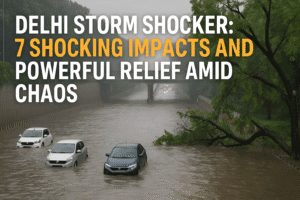Delhi Storm Shocker: 7 Shocking Impacts and Powerful Relief Amid Chaos
Delhi experienced a sudden thunderstorm that dramatically dropped temperatures by nearly 7°C, providing relief from a severe heatwave but also causing widespread disruption. The storm’s intense winds and heavy rains overwhelmed the city’s fragile drainage system, flooding key roads and causing traffic chaos. At Indira Gandhi International Airport, 49 flights were diverted and over 180 faced delays or cancellations amid waterlogged terminals. The unexpected downpour exposed critical gaps in urban infrastructure and emergency preparedness, raising concerns over the city’s readiness for erratic weather patterns.
The incident also highlighted public safety risks, including a fatal electrocution due to exposed wiring. The India Meteorological Department warns of continued storms, urging vigilance. Delhi must urgently invest in drainage upgrades, infrastructure audits, and better integration of weather data into city management to enhance resilience. This storm serves as a stark reminder of the need for proactive governance amid growing climate unpredictability.

Delhi Storm Shocker: 7 Shocking Impacts and Powerful Relief Amid Chaos
As Delhiites gasped for respite from a relentless heatwave, nature delivered a dramatic overnight spectacle—a thunderstorm that drenched the city, cooled temperatures, and plunged key areas into chaos. Here’s a breakdown of how the capital navigated this weather rollercoaster and what it reveals about the city’s preparedness.
From Scorching Heat to Sudden Chill
The mercury plummeted by nearly 7°C, with Safdarjung recording a minimum of 19.8°C—the sharpest drop in years for late May. Residents awoke to cooler air but also to waterlogged streets, snapped trees, and traffic snarls. Social media buzzed with videos of cars submerged in underpasses, like one near Delhi Cantonment, where only rooftops of vehicles peeked above floodwaters.
Flight Turbulence: 49 Diversions and Terminal Chaos
Delhi’s Indira Gandhi International Airport faced a night of turmoil. As winds gusted up to 82 km/h, 49 flights (17 international) were diverted to cities like Jaipur and Lucknow. Over 180 flights faced delays or cancellations by morning, with Terminal 3 battling waterlogged entryways. Travelers shared frustration online, highlighting the airport’s struggle to manage sudden weather shifts—a recurring issue during monsoon months, albeit unseasonal for May.
City Streets Turn Rivers: Infrastructure Under Strain
Key corridors like ITO, Minto Road, and Dhaula Kuan transformed into waterways, exposing Delhi’s fragile drainage system. While the India Meteorological Department (IMD) had issued a red alert, the intensity of the rain—81.2 mm in six hours at Safdarjung—overwhelmed infrastructure. Locals criticized delayed municipal responses, recalling similar flooding during monsoons. The incident raises questions about pre-monsoon preparedness, even as climate patterns grow more erratic.
Meteorological Insights: Why This Storm Stood Out
- Wind Fury: Gusts hit 82 km/h, uprooting trees and power poles. Palam and Pragati Maidan saw speeds of 72 km/h and 76 km/h, respectively.
- Rainfall Records: Areas like Pusa (71 mm) and Mayur Vihar (48 mm) experienced near-monsoon-level downpours overnight.
- Temperature Swing: A rare 12°C drop within hours—Safdarjung plunged from 31°C to 19.8°C between midnight and dawn.
Hidden Dangers: Electrocution Risks and Safety Gaps
Beyond the visible chaos, the storm carried lethal risks. A boy was electrocuted at a park in a separate incident, underscoring vulnerabilities like exposed wiring—a hazard amplified by waterlogging. Authorities face pressure to audit public spaces for such dangers ahead of monsoon season.
What’s Next? Weather Outlook and Lessons Learned
The IMD predicts continued thunderstorms with a high of 38°C, urging residents to stay alert. For Delhi, the storm is a wake-up call:
- Urban Planning: Invest in drainage upgrades and real-time weather integration for traffic/flight management.
- Public Safety: Regular infrastructure audits to prevent electrocution and tree-related accidents.
- Traveler Advisory: Check flight statuses and avoid waterlogged zones during alerts.
While Delhi’s storm brought temporary relief, it also laid bare systemic gaps. As climate variability increases, blending accurate forecasting with proactive governance will be key to transforming chaos into resilience. For now, the city mops up—and braces for the next test.
You must be logged in to post a comment.